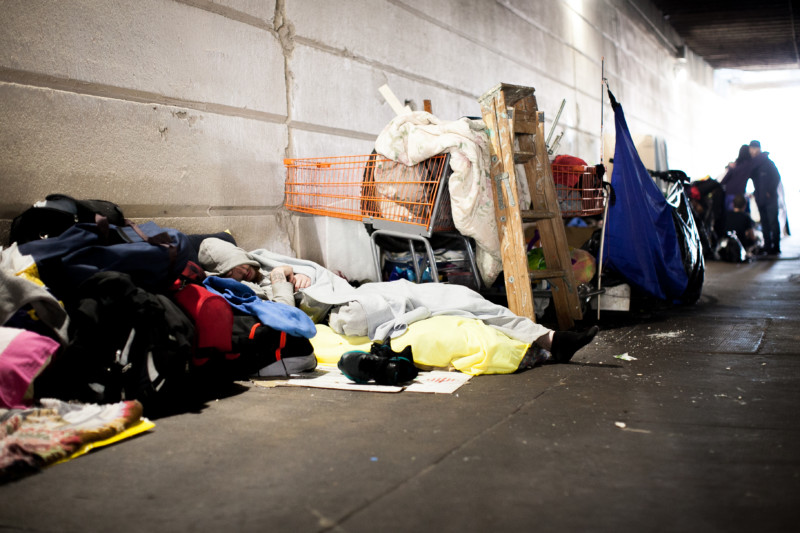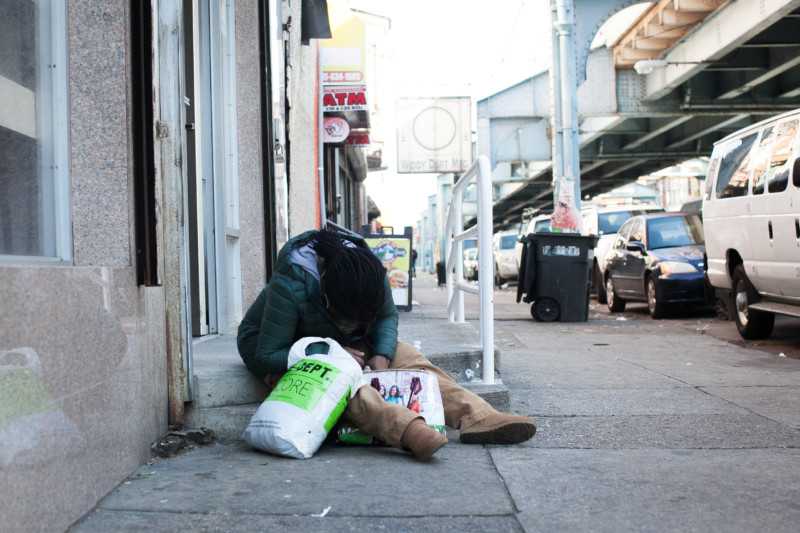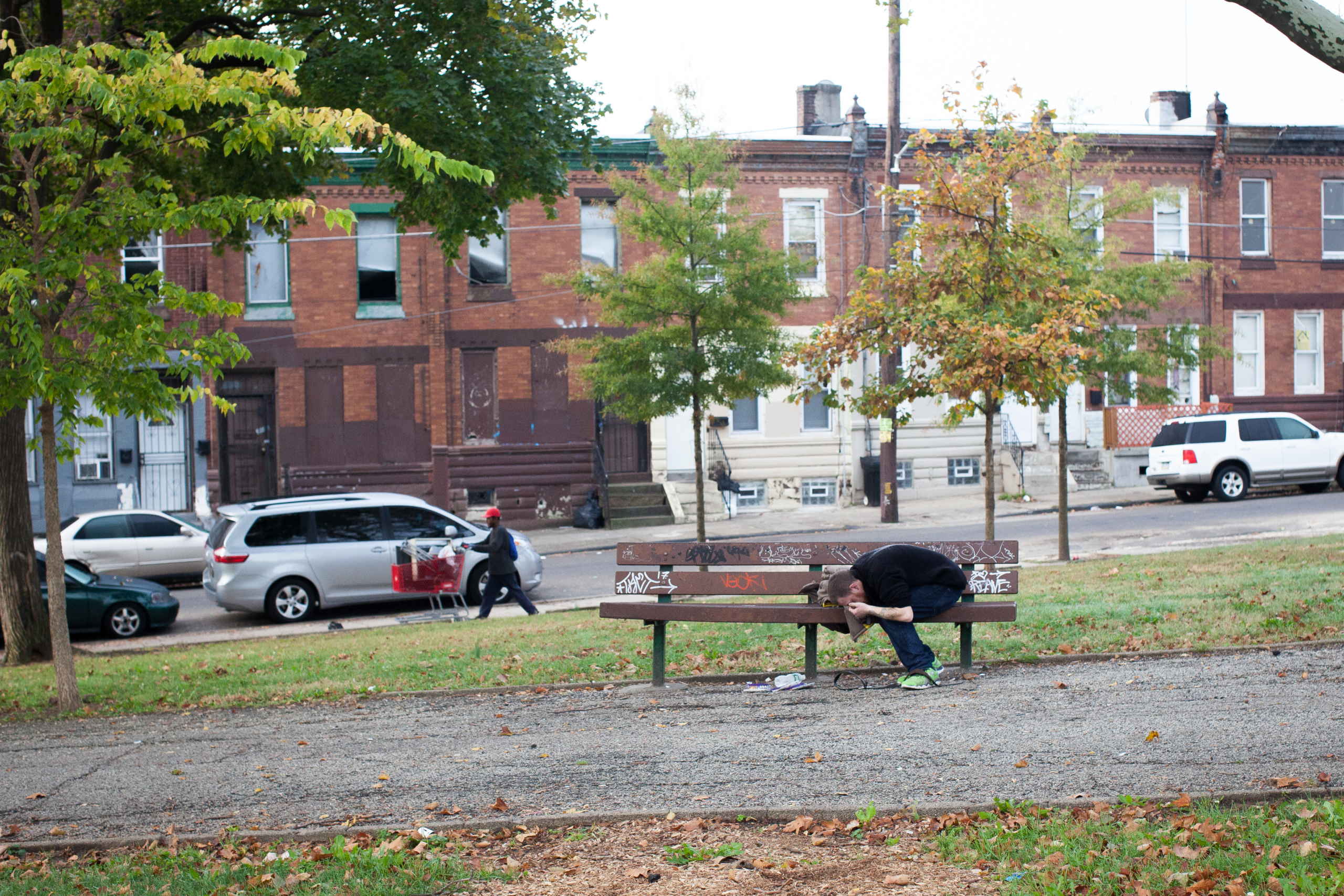TV journalists Vince Lattanzio and Mat Mezer heard a commotion while reporting on a story in the Kensington neighborhood of Philadelphia. A woman was dying of an overdose on the sidewalk. Her lips were turning blue. Despite having learned how to use Narcan the week prior, Lattanzio wasn’t carrying any when they found her. They called 911.
The NBC 10 team was only the first in a string of journalists to discover an overdose in progress in The Badlands, a pocket of North Philadelphia where drug users can purchase some of the most potent heroin on the East Coast. On any given day there, police, paramedics, outreach workers, and drug tourists—some of whom traveled to the city years ago to buy heroin and have yet to leave—fill the lawns, sidewalks, and streets. More recently, the neighborhood has hosted an influx of journalists and television celebrities like Dr. Oz, who are there to report on the scene.
This increase in opioid-related news coverage has revived an ethical debate in Philadelphia—a city that suffered more than 900 fatal overdoses in 2016 and is projected to hit more than 1,200 this year—about when journalists should help and when they should report: Should individuals reporting on populations at high risk of overdose carry Narcan? Some journalists, including a high-profile local columnist, think the answer is “yes,” and are prepared to intervene. And while professional organizations like the Society of Professional Journalists have yet to take an official stance, they aren’t opposed.
“Using Narcan is similar to performing CPR or the Heimlich maneuver—if a journalist is trained in these life-saving procedures, they would, could, and should save someone in distress,” SPJ President Rebecca Baker tells CJR. “We’ve seen journalists stepping out of their roles as news gatherers to help people in life-threatening situations, such as rescuing people from hurricane-flooded areas in Texas. This is simply a different type of rescue.”
Using Narcan is similar to performing CPR or the Heimlich maneuver—if a journalist is trained in these life-saving procedures, they would, could, and should save someone in distress.
Mike Newall, a city columnist for The Philadelphia Inquirer who’s been writing about the overdose crisis since May, started reporting on the opiate problem when the rise in public overdoses intersected with his interest in exposing recreation centers that had fallen into disrepair. He’d caught a tip that the McPherson Square librarians were trained to use and equipped with Narcan. Overdoses there were so common that the library staff could differentiate a heroin overdose (a slow slide), from a fentanyl overdose (a hard fall), by the sounds they made through the library’s bathroom door.
On Newall’s second day of reporting that story, a woman overdosed while he was interviewing her in Needle Park, a name locals gave to the McPherson Square library lawn. The columnist, who dialed 911, felt helpless—until Chera Kowalski, a McPherson librarian, burst with her little blue pouch through the library’s doors.
By the time Kowalski got there with her Narcan kit, the woman’s partner had already given her a dose. Kowalski, who at that time had experience reversing three or four overdoses, put her in the recovery position—her head tilted back, body on one side, and hand against her chin—and together they waited for the ambulance to arrive.
ICYMI: Breitbart’s “sinister” response to Washington Post‘s recent bombshell
“Seeing the doors bang open and this librarian, who you wouldn’t think would be a lifesaver, come out and do what she did, put the crisis in that neighborhood into really sharp relief for me,” Newall says. “To see how they responded to a crisis, it struck me as the right way to do it, and the way we should all be doing it right now.”
Since Newall covered that story, he’s been in Kensington every week. He’s written more than a dozen columns on the subject, including one about that experience as it connects to the untimely death of his brother, and why he now carries a little blue pouch of his own.
“The only thing in Kensington that drowns your voice out more than the train is the ambulances,” he says.

An unidentified man lies unconscious under the Emerald Street Bridge in the Kensington neighborhood of Philadelphia. The bridge is a popular place for drug users who have no place to go. Photo by Jillian Bauer-Reese.
In Pennsylvania, anyone can walk into a pharmacy and purchase Narcan (a brand name for naloxone) as long as it’s in stock. Some pharmacies choose not to carry it due to the cost, but as of October 24, Walgreens announced it will be carrying the medication at all of its 8,000-plus stores. In Philadelphia, as of late October, two doses of the nasal spray cost $85 without insurance. With insurance, the out-of-pocket cost goes down.
Newall got his overdose reversal kit from Elvis Rosado, the education and outreach coordinator for the local harm reduction nonprofit Prevention Point. It includes two 4-mg naloxone nasal sprays (Narcan), one 1-mg auto-injector of naloxone with a nasal adapter (Evzio), rubber gloves, and a rescue breathing mask—which he keeps in his bag at all times. Though he has yet to reverse an overdose, he did give one of the auto-injectors to a person whose friend was conscious, but looked high-risk. The others, he’s left alone.
“I’m a columnist, so maybe I’m free to raise my hand and say, ‘I am in favor of saving lives,’” says Newall. But, he adds, “I’m not a first responder; I’m a columnist, I’m a news reporter. I don’t walk around like, ‘Hey, how many people can I Narcan today?’”
For nearly six months between 2015 and 2016, Lattanzio and Mezer were part of a team of journalists from Philadelphia’s NBC affiliate who worked on an Emmy-winning news documentary called Generation Addicted. The 30-minute television special and online feature focused on the growing opioid crisis in Philadelphia.
The station would not give Lattanzio and Mezer permission to speak with CJR, but one of their reporting partners, Morgan Zalot, says they believe the woman who overdosed on the sidewalk survived. However, the experience still sparked an ongoing conversation in the newsroom about whether journalists should carry the medication while on the job. According to Zalot, who left the station last year, everyone there—including reporters, videographers and producers—agreed that they should.
“I’m never gonna be okay with standing by and essentially watching someone suffocate, or watching someone die, when I know that there’s something relatively easy that I could do to prevent it,” says Zalot, now a graduate student pursuing a master’s degree in public health at Temple University. “At that point, it’s not about journalism; it’s about someone’s life. It’s not about the story anymore.”
Newall would draw the line at driving into the neighborhood with the intent to distribute boxes of Narcan.

An unidentified woman sits unconscious on the stoop of a storefront under the El tracks in the Kensington neighborhood of Philadelphia on November 2, 2017. Photo by Jillian Bauer-Reese.
Opinions like Newall’s and Zalot’s challenge the traditional ethical notion that journalists should remain rigidly detached from the individuals on whom they report. In the past, some journalists have taken this hard-line approach to what others consider the extreme.
ICYMI: Heads up! Two dozen freelancers told CJR these are best outlets to pitch
In 2010, the New York Post published R. Umar Abbasi’s photograph of a man seconds before he died on the tracks of a New York subway train. Abbasi later wrote in the Post that he tried to use his flash to alert the conductor that the man had been pushed in the train’s path, but many individuals—including journalists—argued that he could have done more, and doubted that claim.
More than a decade earlier, in the mid-1990s, reporter Sonia Nazario stood back while a family ate just three hotdogs for an entire meal. After a photographer she was working with gave one family they were profiling a bag of groceries, she criticized his ethics, telling CJR, “I think what was beaten into me early as a reporter was you don’t intervene or change a story that you’re writing about.”
Then there was Kevin Carter’s 1993 Pulitzer Prize-winning photo of a starving Sudanese toddler, taking what appeared to be her last breaths, with a vulture looming ominously behind her. In the documentary The Death of Kevin Carter, Carter’s then-girlfriend said that while the toddler got up and continued moving after the photograph was taken, many argued that he should have done more to help. He died by suicide in 1994.
According to media ethicist Stephen Ward, the belief that journalists should not become involved with the individuals on whom they report comes from century-old ethics that protect them from compromising their independence. So, for example, journalists should not develop personal relationships with politicians, or those relationships might influence their work.
But over the years, Ward explains, journalists have interpreted that principle to mean the need for an absolute, unapproachable distance—teetering on calloused—between their sources and themselves. The notion that journalists should remain detached, Ward says, was never meant to cover an extreme case such as an individual dying right in front of them. Journalists are not and should not be “stenographers of fact,” says Ward, who lectures at the University of British Columbia.
Journalists should assist people who are in distress, he explains, if they can do so without endangering themselves. And if editors happen to notice bias in the journalist’s work as a result, there are ways to deal with it while protecting their independence.
To me it’s not very different than photography in the sense that you need to determine when you are there to take a photo, [and] when you are there to help somebody.
Regardless of what journalists decide to do, Billy Penn editor Shannon Wink is encouraging her staff and other local media organizations to get training so they can make informed decisions. On November 4, Billy Penn hosted a free, three-hour Narcan event with Prevention Point at the 2017 Klein News Innovation Camp. Twelve journalists from a variety of outlets, including Philadelphia Weekly and WHYY, attended.
There was no debate about ethics, Wink says, as those in attendance seemed to have already made up their minds.
“To me it’s not very different than photography in the sense that you need to determine when you are there to take a photo, [and] when you are there to help somebody,” Wink says. “It seems very cut and dry to me.”
And it’s pretty clear for Newall, too. While he’s lost some sleep over certain things related to his addiction coverage—“God forbid, my mother, who didn’t see my brother for six months, picked up the New York Daily News and there he is on the front page.”—carrying Narcan has never been one of them.
CJR’s health care reporting is sponsored in part by a grant from the Commonwealth Fund.
ICYMI: The shocking observation a HuffPost editor made about recent sexual harassment stories
Jillian Bauer-Reese is an assistant professor of journalism in the Klein College of Media and Communication at Temple University, where she teaches a course called Solutions Journalism: Covering Addiction. She is also a person in long-term recovery. You can contact her at jbr@temple.edu or on Twitter @thesmallpicture.

